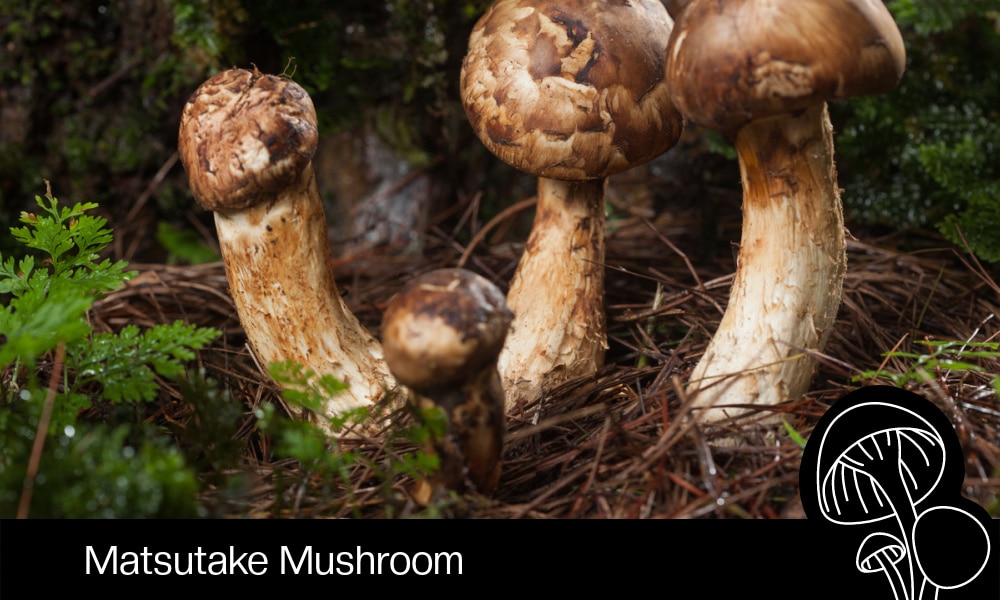The matsutake mushroom, also known as the pine mushroom, has become popular in recent years due to its distinct nutty flavor. As a result, you can find this fungus in all types of culinary dishes around the world.

What Are Matsutake Mushrooms?
Matsutake mushrooms, Tricholoma matsutake, are a type of mycorrhizal fungi found in the forests of East Asia and some parts of North America. The name matsutake comes from the Japanese word matsu, which means “pine tree.” Matsutake mushrooms grow on the roots of trees like pine, so it makes sense that they would get their name from this native tree species.
Matsutake mushrooms have a distinctive appearance. They are white or tan with a long thick stem and large cap. The caps of the matsutake mushroom can range from 1 to 6 inches in diameter and have a convex shape. The gills on the underside of the mushroom are pale cream or light yellow in color. The smell of matsutake mushrooms is strong and spicy.
Matsutake mushrooms are sought after and fetch a high price due to their rich flavor. Despite their popularity, matsutake mushrooms can be hard to find as the fungi are rare and difficult to cultivate. Their scarcity has made them expensive to purchase fresh or dried.
What Does a Matsutake Mushroom Taste Like?
Matsutake mushrooms have an intense flavor that is earthy and spicy with a hint of umami. You can compare the taste of matsutake mushrooms to the flavor of cinnamon. When they are cooked, they have a bit of a fishy aroma and a flavor that is unique to this mushroom. The texture of matsutake mushrooms is firm and chewy.
How to Cook Matsutake Mushrooms.
One of the most common ways to cook with matsutake mushrooms is to use them as a seasoning in soups, stews, and sauces. You can also stir-fry them with vegetables or meats before being added to dishes. Or you can cook and serve them as an accompaniment to the main course.
In Japan, matsutake mushrooms are enjoyed raw in sashimi or sushi dishes. Japanese chefs often serve them with rice, and they make an appearance in traditional dishes like sukiyaki and tempura. They are even used to make dashi, a popular Japanese soup stock.
How to Store Matsutake Mushrooms
If you have acquired some matsutake mushrooms, you'll want to make sure that they stay fresh and tasty until you're ready to use them. To do this, proper storage is key. It's best to avoid storing matsutake mushrooms for long periods of time. Try to use them within 2 or 3 days.
The best way to store matsutake mushrooms is in a paper bag or container lined with paper towels in your refrigerator. Don't wash them before storing as this can cause the mushrooms to spoil. Store the mushrooms away from other foods or liquids so they don't absorb other odors and flavors.
When it comes time to use the matsutake mushrooms, wipe them with a damp cloth or give them a quick rinse in cold water. Trim away any tough or woody stems, and cook them right after rinsing.
Matsutake Mushroom Benefits
Matsutake mushrooms are an excellent choice for adding nutrients to any meal. They contain a variety of essential vitamins and minerals as well as protein and fiber. They are also low in calories and fat. They have antioxidants that boast anti-inflammatory properties that may help reduce inflammation in the body.
Matsutake Vs. Shiitake
Matsutake and shiitake mushrooms are two popular varieties of edible mushrooms, but there are some key differences between them. Matsutake mushrooms tend to have a more bulbous cap than shiitake mushrooms, and their stems are thicker. The spores on matsutake mushrooms also tend to be pale yellow compared to the dark brown spores seen on shiitake mushrooms.
Matsutake mushrooms have a unique smell and taste, while shiitakes have an earthy flavor that is more subtle than what you get from matsutakes. Matsutakes possess a unique umami flavor that is both sweet and spicy, while shiitakes have a more savory taste. Matsutakes have an earthy aroma that is often described as "pine-like," while shiitakes have a more woodsy, smoky scent.
Matsutake mushrooms are among the most expensive and prized of all edible mushrooms. This is due to the scarcity of matsutake mushrooms as well as their unique and flavorful taste. The intense flavor of matsutake mushrooms is something that cannot be replicated with other types of mushrooms. Shiitake mushrooms are easier to find, so they cost much less than matsutakes.


